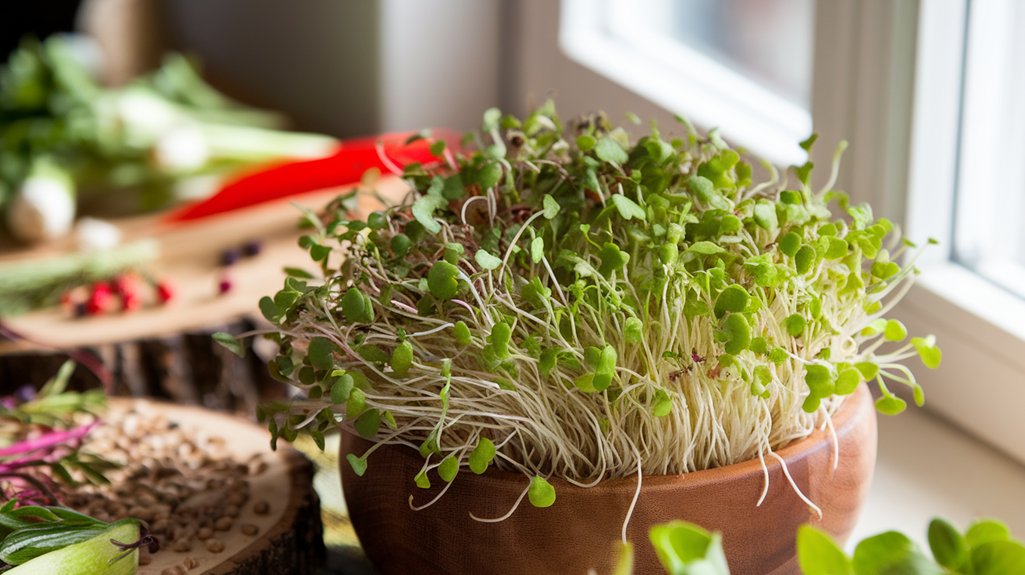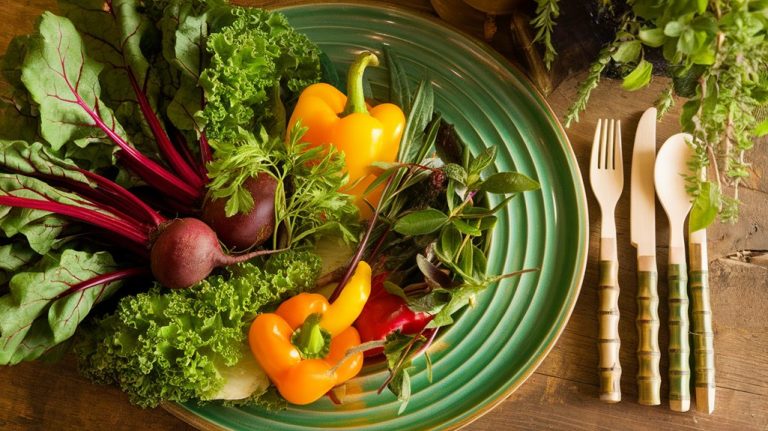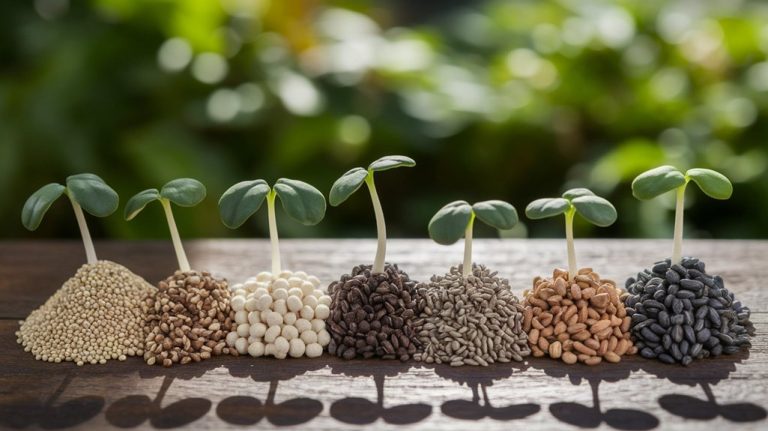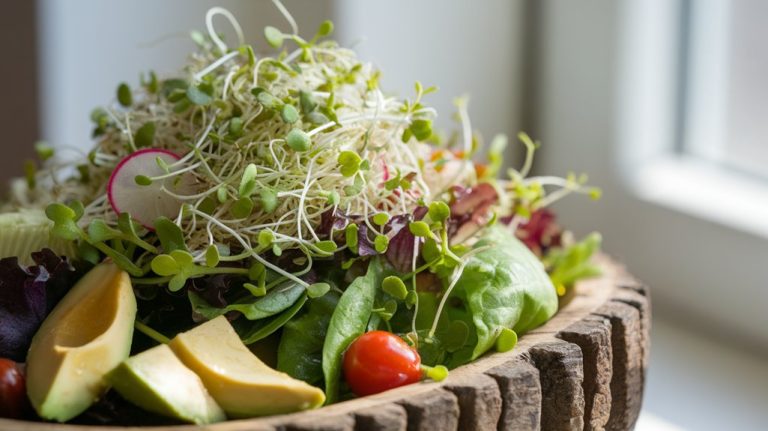Sprout Your Way to Healthy Meals
Sprouts are a fantastic way to boost your meals with nutrients. They’re packed with vitamins, protein, and digestive enzymes, making them guilt-free additions to any dish. Sprouting at home is super easy—just soak seeds, rinse them, and watch them grow. I love adding alfalfa sprouts to my sandwiches or mung bean sprouts to salads for extra texture. Plus, they’re eco-friendly and reduce food waste. Stick around, and I’ll share more ways to incorporate these healthy gems into your meals!
Key Takeaways
- Sprouts are nutrient-dense, providing essential vitamins, minerals, and plant-based protein for a healthy diet.
- Growing sprouts at home is simple and requires minimal space, making it accessible for everyone.
- Incorporate sprouts into salads, sandwiches, and stir-fries for added flavor, texture, and nutrition.
- Store sprouts in a cool, dark place and rinse regularly to maintain freshness and crispness.
- Sprouting reduces food waste and conserves water, supporting a more sustainable food system.
The Nutritional Powerhouse of Sprouts
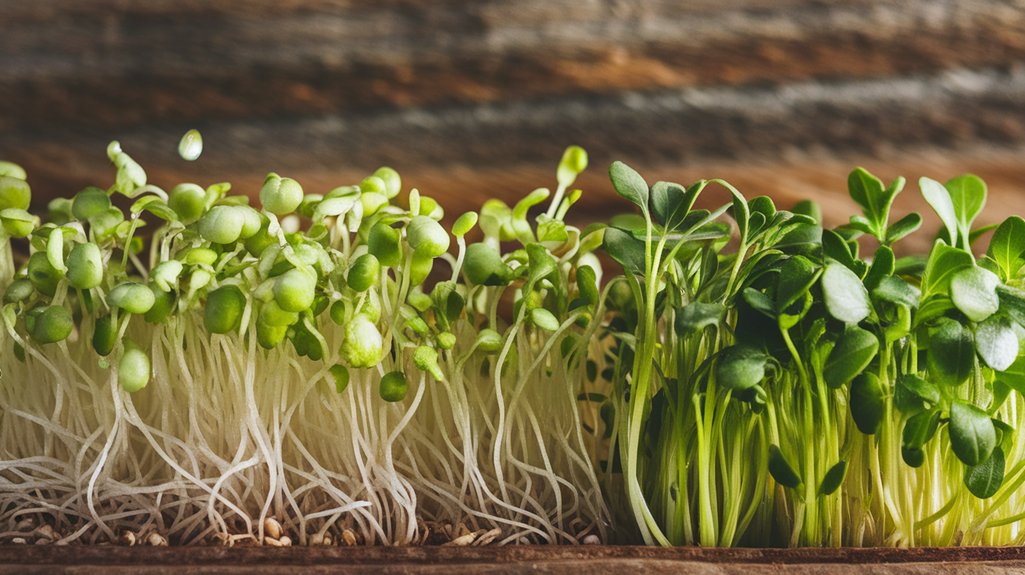
When I discovered the incredible benefits of sprouts, I couldn’t believe how much nutrition these tiny powerhouses can pack into a single bite.
Sprouts are rich in vitamins, minerals, and enzymes that our bodies crave. For instance, they boast high levels of vitamin C, vitamin K, and folate, all essential for boosting immunity and promoting cell health.
They also contain fiber, which aids digestion and keeps us feeling full longer. What’s fascinating is that sprouting enhances nutrient absorption, making it easier for our bodies to utilize these vital components.
Plus, they’re low in calories, making them a perfect addition to any meal. Incorporating sprouts into my diet has truly transformed my health and overall well-being.
Easy Steps to Sprout at Home
Sprouting at home is simpler than you might think, and it only takes a few easy steps to get started. Here’s how I do it:
- Choose your seeds: Opt for sprout-friendly seeds like alfalfa, broccoli, or lentils.
- Rinse and soak: Rinse the seeds thoroughly and soak them in water for 4-8 hours.
- Drain and sprout: Drain the seeds, place them in a jar or sprouting tray, and rinse them twice daily.
- Harvest: In about 3-7 days, you’ll see sprouts ready for your meals!
With minimal effort, you can grow nutritious sprouts right in your kitchen.
They’re not just tasty; they pack a powerful punch of vitamins and minerals that can elevate your health!
Incorporating Sprouts Into Your Meals
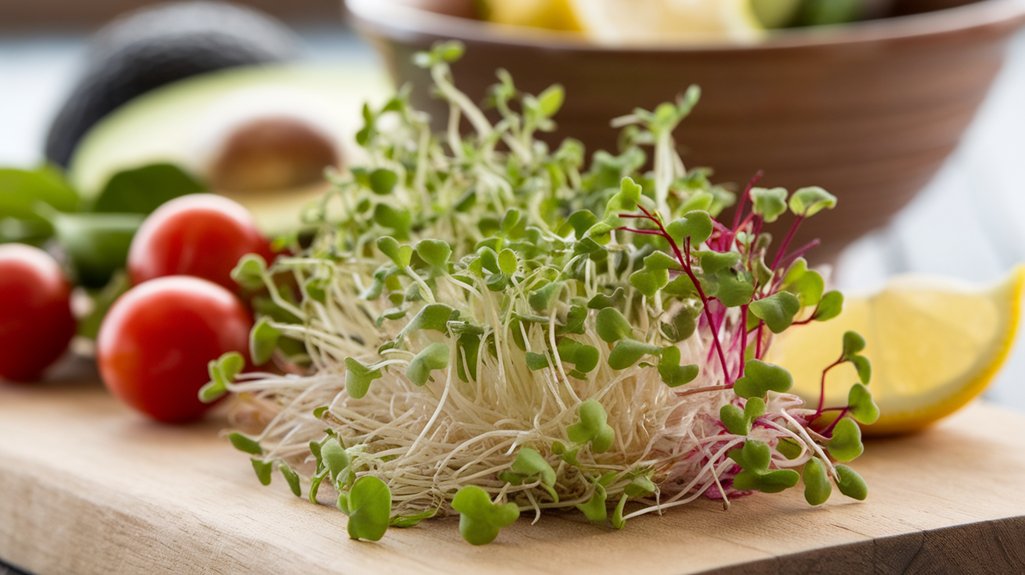
I love incorporating sprouts into my meals because they pack a nutritional punch, offering vitamins and enzymes that support overall health.
Whether I’m whipping up a quick salad or adding them to a stir-fry, there are countless easy recipes to explore.
Plus, I’ll share some simple sprouting techniques that make it easy to enjoy these little powerhouses at home!
Nutritional Benefits of Sprouts
Incorporating sprouts into your meals not only enhances flavor but also packs a powerful nutritional punch.
These tiny powerhouses are rich in essential nutrients that can elevate your health. Here’s what I love about them:
- High in Vitamins: Sprouts are loaded with vitamins A, C, and K, which support immune function and skin health.
- Rich in Protein: They’re an excellent source of plant-based protein, making them perfect for plant lovers.
- Digestive Benefits: Sprouts contain enzymes that aid digestion and improve gut health.
- Low in Calories: With their low-calorie count, they’re a great addition to any meal without the guilt.
Easy Sprout Recipes
Adding sprouts to your meals opens up a world of delicious possibilities. I love using alfalfa sprouts in my sandwiches for that extra crunch and nutrition. Just toss them into a simple turkey or hummus wrap, and you’ve got a satisfying meal in minutes.
For salads, I often incorporate mung bean sprouts for their delicate texture and nutty flavor; they’re perfect sprinkled over mixed greens. I also enjoy making a quick stir-fry with broccoli sprouts, bell peppers, and a splash of soy sauce. The sprouts add a fun twist and pack a nutritional punch!
Sprouting Techniques at Home
While sprouting at home may seem daunting, it’s surprisingly simple and rewarding. I’ve found that incorporating sprouts into my meals not only boosts nutrition but adds a delightful crunch.
Here are some easy techniques to get you started:
- Choose Your Seeds: Lentils, mung beans, and alfalfa are great options.
- Rinse and Soak: Rinse seeds thoroughly, then soak them in water for about 8-12 hours.
- Drain and Sprout: Place the seeds in a sprouting jar or tray, draining excess water, and keep them moist.
- Harvest and Enjoy: In just a few days, you’ll have fresh sprouts ready to toss into salads, sandwiches, or stir-fries!
With these steps, you’ll soon see how simple sprouting can enhance your meals.
Delicious Sprout Recipe Ideas
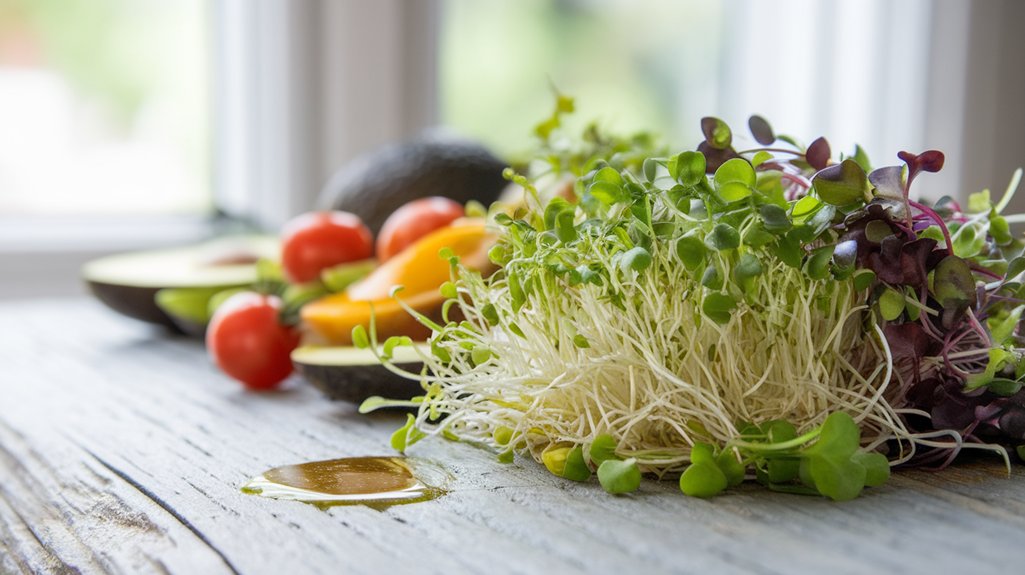
I love incorporating sprouts into my meals because they add a nutritious punch and vibrant flavor.
Whether I’m tossing them into a refreshing salad, stir-frying for a quick dinner, or blending them into a hearty soup, there are endless ways to enjoy these little powerhouses.
Let’s explore some delicious sprout recipe ideas that can elevate your healthy eating game!
Nutritious Sprout Salads
When it comes to wholesome eating, sprout salads stand out as a vibrant and nutrient-packed option that can easily elevate any meal.
I love how they combine fresh flavors with a wealth of health benefits. Here are some delicious sprout salad ideas to inspire you:
- Mixed Green Sprout Salad: Combine alfalfa, broccoli, and lentil sprouts with a citrus vinaigrette.
- Mediterranean Delight: Toss chickpea sprouts with cherry tomatoes, cucumber, and feta for a refreshing twist.
- Asian-Inspired Crunch: Mix mung bean sprouts with shredded carrots, bell peppers, and a sesame dressing.
- Quinoa Sprout Bowl: Layer quinoa, sunflower sprouts, avocado, and lime juice for a filling meal.
These salads aren’t only tasty but also packed with vitamins, minerals, and protein, making them a fantastic choice for any diet!
Flavorful Sprout Stir-fries
Stir-frying is a fantastic way to bring out the natural flavors of sprouts while adding a satisfying crunch to your meals.
I love starting with a mix of bean sprouts, broccoli sprouts, and alfalfa sprouts for a vibrant dish. Just toss them in a hot pan with a splash of sesame oil, garlic, and ginger for an aromatic base.
You can easily customize your stir-fry by adding colorful veggies like bell peppers or snap peas. A drizzle of soy sauce or a sprinkle of sesame seeds elevates the flavor profile.
Not only are these dishes quick to prepare, but they also pack a nutritional punch, full of vitamins and minerals.
Give it a try, and you’ll enjoy a delicious, healthy meal in no time!
Savory Sprout Soups
Although soups might seem simple, they offer a wonderful opportunity to showcase the unique flavors and textures of sprouts.
I’ve experimented with various combinations and found that sprouts can elevate a basic soup to something extraordinary. Here are some ideas to inspire you:
- Miso Sprout Soup: Combine miso paste with fresh sprouts for a savory umami kick.
- Creamy Broccoli Sprout Soup: Blend steamed broccoli sprouts with potatoes and vegetable broth for a creamy, nutritious delight.
- Spicy Lentil and Sprout Soup: Add lentils and your favorite spices to create a hearty, protein-packed meal.
- Herbed Sprout Vegetable Soup: Toss in an assortment of sprouts with fresh herbs for a refreshing twist.
Try these recipes, and you’ll see just how versatile sprouts can be in your soups!
Tips for Storing and Maintaining Freshness
To keep your meals fresh and nutritious, it’s essential to understand the best practices for storing food.
First, I always recommend keeping sprouts in a cool, dark place, ideally in the refrigerator, where they can last up to a week. Use breathable bags or containers to prevent moisture buildup, which can lead to spoilage.
I find that rinsing sprouts every few days helps maintain their crispness and flavor. If you’ve prepped your sprouts, try using airtight containers to keep them fresh longer.
Also, avoid storing them with ethylene-producing fruits like apples and bananas, as they can accelerate spoilage.
The Environmental Benefits of Sprouting
Maintaining freshness in food isn’t just about taste; it also plays a role in environmental sustainability.
When I sprout seeds at home, I’m making a choice that benefits both my health and the planet. Here’s how sprouting helps the environment:
- Reduces Food Waste: Sprouting allows me to use seeds that might otherwise be discarded.
- Conserves Water: It takes significantly less water to grow sprouts than to cultivate traditional crops.
- Decreases Carbon Footprint: Growing sprouts indoors cuts down on transportation emissions.
- Promotes Biodiversity: I can experiment with various seeds, supporting crop diversity.
Incorporating sprouts into my meals not only nourishes my body but also contributes to a more sustainable food system.
Frequently Asked Questions
Are There Any Risks Associated With Eating Raw Sprouts?
I’ve often wondered about the risks of eating raw sprouts. They can be delicious and nutritious, but they’re also linked to foodborne illnesses due to bacteria like E. coli and Salmonella.
I always wash them thoroughly, but it’s tough to eliminate all risks. If you’re pregnant, elderly, or have a weakened immune system, you might want to avoid raw sprouts altogether.
It’s always better to err on the side of caution when it comes to food safety!
How Long Can I Store Sprouts Before They Go Bad?
I’ve found that fresh sprouts can last about 5 to 7 days in the fridge, but it’s essential to check for signs of spoilage.
I always store them in a breathable container and keep them dry to extend their freshness. If they start to smell off or become slimy, it’s best to toss them.
I enjoy using sprouts within the first few days for the best flavor and nutritional benefits.
Can I Sprout Any Type of Seed?
You can sprout many types of seeds, but not all of them are suitable. I’ve had great success with common options like alfalfa, broccoli, and lentils.
However, some seeds, like those from nightshade plants, can be toxic. Always check if the seeds are safe for sprouting.
I recommend using organic seeds specifically meant for sprouting, as they often yield the best results.
Happy sprouting!
Do Sprouts Have Any Allergens I Should Be Aware Of?
Absolutely, sprouts can have allergens. While most sprouts, like broccoli and alfalfa, are generally safe, some individuals may experience reactions.
I’ve learned that certain people are sensitive to specific proteins or compounds in sprouts, leading to allergies. It’s essential to monitor how your body reacts and consult with a healthcare professional if you have concerns.
I always recommend starting with small amounts to gauge your tolerance before diving into larger servings.
How Do I Know When My Sprouts Are Ready to Eat?
I check my sprouts daily to see when they’re ready to eat.
Typically, they’re ready when they’ve grown a few small leaves and are about 1-2 inches long.
I also look for a fresh, crisp appearance and a pleasant smell.
If they start to turn brown or smell off, I know it’s time to toss them.
Enjoying them at their peak ensures I get the best flavor and nutrients!
Conclusion
Incorporating sprouts into your meals has been a game-changer for me, not just in nutrition but also in flavor. With their impressive health benefits and versatility, it’s easy to see why they’re a staple in my kitchen. By sprouting at home, I not only ensure freshness but also reduce my environmental footprint. I encourage you to give it a try—your taste buds and your body will thank you! Let’s embrace the power of sprouts together!

